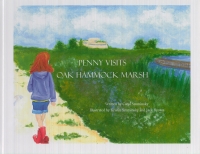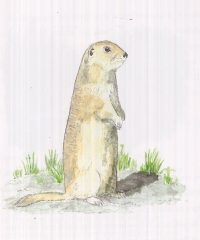| ________________
CM . . .
. Volume XV Number 18. . . .May 1, 2009 
 |
Penny Visits Oak Hammock Marsh.
Carol Szuminsky. Illustrated by Kristin Szuminsky & Jack Brown.
Winnipeg, MB: Peanut Butter Press (www.peanutbutterpress.ca), 2008.
28 pp., hardcover, $20.00.
ISBN 978-0-9735579-7-8.
Subject Headings:
Oak hammock Wildlife Management Area-Juvenile fiction.
Marsh ecology-Manitoba-Juvenile fiction.
Marsh animals-Manitoba-Juvenile fiction.
Marsh plants-Manitoba-Juvenile fiction.
Grades 2-4 / Ages 7-9.
Review by Gregory Bryan.
** /4
|
| |
|

excerpt:
"They certainly are smart, aren't they?"
"Yes, they are," Penny agreed. "Just like you, Grandpa! How did you learn so much about birds?"
Grandpa let out a little chuckle. "It took time and practice before I could recognize birds in nature. I studied the pictures in bird books to learn what each bird looked like and read about them," he answered seriously.
Manitoba author, Carol Szuminsky's, latest work is Penny Visits Oak Hammock Marsh, in which Szuminsky's recurring character, Penny, and Penny's grandfather spend a day observing nature at the world renowned birding site, Oak Hammock Marsh. The character of Penny has previously appeared in other Szuminsky books, Why Penny Loved Peanuts (2004) and Penny Picks the Perfect Pet (2007). Located just a short drive north of Winnipeg, Oak Hammock Marsh attracts birds and bird lovers in huge numbers. As such, it is an ideal location for an experienced birder like Penny's grandfather to take a birding novice such as Penny.
 The illustrations for Penny Visits Oak Hammock Marsh were provided by the author's daughter and father—the real life Penny and Grandpa from the book. Unfortunately, there simply are not enough pictures for a picture book, at least in relation to the text. Some pages are full text, without any illustration and, toward the end of the story, there is even a double page spread without illustration. This leaves the book seriously out of balance. The illustrations for Penny Visits Oak Hammock Marsh were provided by the author's daughter and father—the real life Penny and Grandpa from the book. Unfortunately, there simply are not enough pictures for a picture book, at least in relation to the text. Some pages are full text, without any illustration and, toward the end of the story, there is even a double page spread without illustration. This leaves the book seriously out of balance.
Szuminsky needed to be more discerning with her word choices. There is far too much unnecessary text. A much firmer editorial hand was required. For instance, it is not necessary for the reader to be told that Penny buckled up her seat belt when she entered her grandfather's truck. This detail is not pertinent to the story and easily could have been left unsaid. This is just one of many similar examples throughout the book. Indeed, Szuminsky tells too much and does not show enough. The dialogue in a story is a good way for an author to show what is happening. Szuminsky's dialogue, however, is generally unconvincing. Although it is evident that a warm relationship exists between Penny and her grandfather, the dialogue comes across as being unrealistic and didactic. For instance, when Grandpa sings a short song about a muskrat, Penny responds, "That's not correct grammar, Grandpa, but it's so cute! Let's sing it together." After singing the song, Penny concludes, "We're having so much fun, and I'm learning a lot too!"
Szuminsky's writing also lacks focus. She tries to be too all-encompassing, including a mishmash of details in what reads as a scattergun approach to writing. The author even states that the book can be used as a field guide. That is hardly an appropriate use for a book such as this when there are many high quality bird field guides for children on the market.
The absence of critical incidents or any form of a plot climax leaves the text flat and somewhat unappealing. Yet, at the same time, the information on the birdlife is detailed and accurate, and the bird illustrations are generally attractive. As such, this reviewer feels the book would have worked better as a nonfiction informational text devoid of the distracting influence provided by the book's flat, 2-dimensional characters. There is a glossary at book's end that is useful but, again, would better have fitted into an informational text.
The mixed media illustrations appear to have been rendered primarily in watercolour paints and coloured markers. As mentioned, the bird illustrations are quite well done, but the other artwork is simple and does not compare to the attention-grabbing quality artwork that appears in many picture books for children.
Despite many limitations, the text and artwork bird details will appeal to some readers. One pervading theme of the book is conservation and appreciation of our natural surrounds, so the message of the book is an important one. Those trying to foster a child's interest in birds may find something of value in Penny Visits Oak Hammock Marsh. Likewise, those with a particular interest in Winnipeg and surrounds might find the book appealing. Oak Hammock Marsh is a wonderful place to visit, whether young or old, and this book is likely to encourage some more people to discover what the place has to offer. Generally, however, I suspect the appeal of the book is limited because there are many vastly superior bird books for children, albeit without the specific focus on Oak Hammock Marsh.
For a small and select group, I recommend this book. I do so, however, while retaining many reservations.
Recommended with reservations.
Gregory Bryan lives in Winnipeg, MB. He is an enthusiastic bird-watcher. Bryan teaches children's literature and literacy courses at the University of Manitoba.

To comment
on this title or this review, send mail to cm@umanitoba.ca.
Copyright © the Manitoba Library Association. Reproduction for personal
use is permitted only if this copyright notice is maintained. Any
other reproduction is prohibited without permission.
NEXT REVIEW |
TABLE OF CONTENTS FOR THIS ISSUE
- May 1, 2009.
AUTHORS |
TITLES |
MEDIA REVIEWS |
PROFILES |
BACK ISSUES |
SEARCH |
CMARCHIVE |
HOME |

 The illustrations for Penny Visits Oak Hammock Marsh were provided by the author's daughter and father—the real life Penny and Grandpa from the book. Unfortunately, there simply are not enough pictures for a picture book, at least in relation to the text. Some pages are full text, without any illustration and, toward the end of the story, there is even a double page spread without illustration. This leaves the book seriously out of balance.
The illustrations for Penny Visits Oak Hammock Marsh were provided by the author's daughter and father—the real life Penny and Grandpa from the book. Unfortunately, there simply are not enough pictures for a picture book, at least in relation to the text. Some pages are full text, without any illustration and, toward the end of the story, there is even a double page spread without illustration. This leaves the book seriously out of balance.